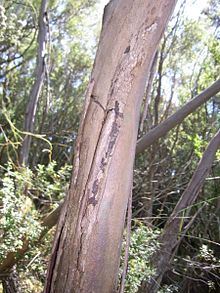- Eucalyptus imlayensis
-
Eucalyptus imlayensis One of the few healthy stems of Eucalyptus imlayensis, Mount Imlay, Australia Conservation status Scientific classification Kingdom: Plantae (unranked): Angiosperms (unranked): Eudicots (unranked): Rosids Order: Myrtales Family: Myrtaceae Genus: Eucalyptus Species: E. imlayensis Binomial name Eucalyptus imlayensis
Crisp & BrookerEucalyptus imlayensis, the Mount Imlay Mallee is a eucalyptus plant. It is endemic to the far south east of New South Wales,[2] only occurring near the summit of Mount Imlay.
Contents
Description
A typical mallee in appearance, growing to 7 metres tall.[3] Bark is smooth, though it sheds in ribbons, curling over near the base. Bark is green when fresh, aging to orange, brown then grey. Juvenile leaves are ovate, without stalks. Sometimes slightly toothed. Adult leaves are quite thick, veiny, straight or curved, 15 cm by 2 cm. The same glossy green above as below the leaf. Leaves held fairly erect. Cream or white flowers form in threes, though the flowering period is not recorded. Gumnuts are stalk-less or practically so, on a flattened stem. The disc surrounding the gumnut is prominent. The stems of seedlings are square in cross section, "winged" at the edges.
Habitat
This small eucalyptus occurs on a rocky slope, near the mountain's summit. Growing as a multi-stemmed mallee, surrounded by low heathland plants on mossy ground. Average annual rainfall at Eden on the coast is 866 mm. However, the rainfall on the mountain would be considerably higher. Mountain mists add extra moisture to the habitat. The soils are poor in nutrient, based from sandstone and conglomerate rocks.[4][5] These sedimentary rocks are from the Devonian period, laid down 395 to 345 million years ago. Part of the Merimbula group placed above Ordovician sediments.
Nearby species include the rare Imlay Boronia, also only found on this mountain. Other nearby plants include Tea Tree, Devil's Twine, Digger's Speedwell, Tasmanian Flax-lily, Rasp Fern, Spiny-head Mat-rush, Scented Paperbark, Common Shaggy Pea, Narrow-leaved Peppermint and Blotchy Mint-bush.
The Imlay Mallee has probably adapted to the relatively high levels of rainfall, mountain mist, and occasional fires. It is suggested that changes to the micro habitat may be hazardous to the plant's survival.[6]
Taxonomy
The holotype of this species was collected in May 1979. The specific epithet imlayensis is named after Mount Imlay. This plant was placed in the Eucalyptus genus. Within the subgenus Symphyomyrtus, the section Maidenaria, the series Johnstonianae and the subseries Imlayensosae.[7] This isolated species appears to be related to the eucalyptus plants of Tasmania.[6]
Dieback
The fungus Phytophthora cinnamomi is a possible cause for the deaths of individual Imlay Mallees in recent times, as is insect attack and drought. Galls on leaves have been observed, caused by an unknown psyllid. Despite the requirement of fires to promote seed germination and new growth in many eucalyptus species, it is not considered advisable to burn this area.[8]
The population of this species consists of around 80 mature plants, with no juveniles. Natural regeneration seldom occurs,[9][10] though the tree may re-sprout from the base after fire. In recent years the population has declined, and the Imlay Mallee is now considered critically endangered by extinction in New South Wales.[3]
References & Further Reading
- ^ Eucalyptus imlayensis — Imlay Mallee, Species Profile and Threats Database, Department of the Environment and Heritage, Australia.
- ^ A Field Guide to Eucalypts - Brooker & Kleinig volume 1, ISBN 0909605629 page 210
- ^ a b "Eucalyptus imlayensis". PlantNET - NSW Flora Online. http://plantnet.rbgsyd.nsw.gov.au/cgi-bin/NSWfl.pl?page=nswfl&lvl=sp&name=Eucalyptus~imlayensis. Retrieved 2010-01-17.
- ^ Floyd, A.G., Australian Rainforests in New South Wales Volume 2 - 1990 ISBN 0-949324-32-9 page 150 (this is a description of the rocks at the rainforest, 250 metres to the south). Plant Net claims the rocks are granite. Presumably, this is an error
- ^ "NSW Department of Environment, Water & Climate Change". Geology of Mount Imlay National Park. http://www.environment.nsw.gov.au/NationalParks/parkGeology.aspx?id=N0023.
- ^ a b "NSW Department of Environment, Water & Climate Change". Mount Imlay National Park - Native Vegetation. http://npws.nsw.gov.au/NationalParks/parkVegetation.aspx?id=N0023.
- ^ "Eucalyptus imlayensis". Eucalink, A Web Guide to the Eucalypts. http://plantnet.rbgsyd.nsw.gov.au/cgi-bin/euctax.pl?/PlantNet/Euc=&name=Eucalyptus+imlayensis.
- ^ "Eucalyptus imlayensis". NSW Threatened Species. http://www.threatenedspecies.environment.nsw.gov.au/tsprofile/profile.aspx?id=10296.
- ^ "NSW Department of Environment, Water & Climate Change". Eucalyptus imlayensis - critically endangered species listing. http://www.environment.nsw.gov.au/determinations/eucalyptusimlayensisFD.htm.
- ^ "NSW Department of Environment, Water & Climate Change". Approved Conservation Advice for Eucalyptus imlayensis (Imlay Mallee). http://www.environment.gov.au/biodiversity/threatened/species/pubs/12623-conservation-advice.pdf.
Categories:- EPBC Act endangered biota
- Eucalyptus
- Myrtales of Australia
- Critically endangered flora of Australia
- Flora of New South Wales
- Mallees
Wikimedia Foundation. 2010.






